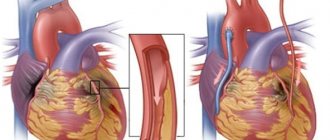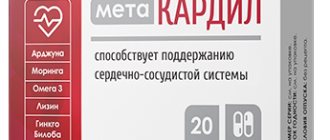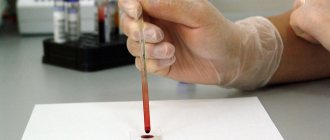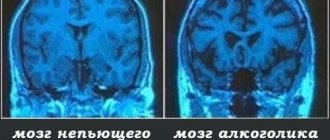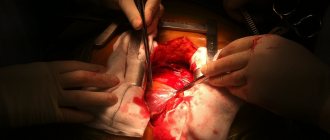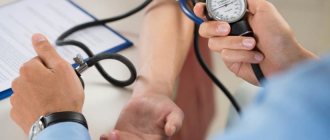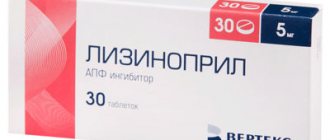Causes of low blood pressure
Physiological factors
Some people have blood pressure readings within 90/60 mmHg. Art. are a variant of the norm. In this case, well-being and performance are not impaired, but when staying in stuffy rooms, a feeling of lightheadedness and weakness is typical. More often, constitutional hypotension occurs in young girls and people of asthenic physique. There are several other options for physiological low blood pressure:
- Orthostatic
. Occurs when there is a sharp transition from a horizontal to a vertical position. Manifested by darkening of the eyes, weakness, dizziness. - Compensatory
. It is observed in residents of high mountain regions, all functional systems of the body have adapted to low oxygen tension. - Postprandial
. It develops 10-20 minutes after eating, mainly when consuming large amounts of carbohydrate foods.
In athletes, a combination of low blood pressure and bradycardia is possible. The condition is caused by the body getting used to constant overload. Hypotension occurs in weather-dependent people with increased air humidity, sudden weather changes, and time zone changes. A short-term drop in pressure occurs in response to exposure to electromagnetic fields and radiation.
Pregnancy
25% of pregnant women have low blood pressure in the early stages. The condition is a consequence of a sharp change in hormonal levels. Usually the problem is aggravated by toxicosis, which is caused by chronic loss of fluid and electrolytes through vomiting. Another typical cause of low blood pressure during gestation is iron deficiency anemia, which is diagnosed in 40-45% of pregnant women.
Protein-energy malnutrition
Following strict diets is the most common cause of low blood pressure in young women. The symptom is associated with a lack of essential nutrients, vitamins, and iron. The clinic appears gradually. Worried about weakness, decreased ability to work. When walking fast or climbing stairs, shortness of breath is observed. It becomes difficult to get up in the morning: you feel dizzy, weak in the legs, and muscle tremors.
Cardiopsychoneurosis
Dysfunction of nervous regulation often leads to a decrease in blood pressure. This reason is more typical for young, emotionally labile patients. Women are more often affected. For low blood pressure in such cases, severe weakness, darkening of the eyes, pressing headache, and pale skin are typical. Symptoms are provoked by prolonged standing, lack of oxygen, and stressful situations.
Anemia
Low blood pressure is one of the main symptoms of anemia. The clinical picture is standard - weakness, dizziness, intolerance to stuffiness. With anemia, a decrease in pressure is accompanied by severe pallor, which persists constantly, and not only when the condition worsens. Taking into account the reason for the decrease in hemoglobin, additional signs are possible: brittle hair and nails, “lacquered tongue,” paresthesia.
Hormonal diseases
Signs of persistently low blood pressure are a specific symptom of hypothyroidism. Such patients freeze even in warm rooms, feel drowsiness and weakness. A decrease in pressure is manifested by headaches and dizziness. If the problem persists for a long time, memory and mental performance deteriorate. Chronic decrease in blood pressure occurs in patients with adrenal insufficiency (Addison's disease).
Organic lesions of the central nervous system
Hypotension develops as a reaction to a violation of the mechanisms of regulation of cardiovascular activity. It is observed with concussions and bruises of the brain, degenerative processes affecting the gray matter. These conditions are characterized by persistently low blood pressure, which cannot be normalized by standard treatment measures.
Acute conditions
Low blood pressure is a symptom of many emergency situations involving shock. A sharp drop in blood pressure is manifested by severe dizziness, lightheadedness, chills and drowsiness. Shock often ends in fainting. The skin becomes pale and covered in cold sweat. Signs of low blood pressure are characteristic of several groups of conditions:
- Hypovolemic conditions
: dehydration, massive bleeding, extensive burns. - Circulatory shock
: anaphylactic, infectious-toxic. - Cardiac pathologies
: acute heart failure, life-threatening arrhythmias, myocardial infarction.
Complications of pharmacotherapy
Overdose of antihypertensive drugs is a common cause of pathologically low blood pressure in the treatment of hypertension. The symptom is more often observed when taking diuretics, nitrates, and beta blockers. The peculiarity is that unpleasant sensations in such patients can appear with normal tonometer readings - systolic pressure at the level of 100-120 mm Hg. Art. This is due to the restructuring of all body systems, adaptation to arterial hypertension.
Rare causes
- Vascular diseases
: pulmonary embolism, dissecting aortic aneurysm. - Congenital and acquired heart defects
. - Damage to the digestive system
: peptic ulcer, pancreatitis, hepatitis and cirrhosis of the liver. - Intoxication
: plant poisons, heavy metal salts, toxic chemicals.
The most common complications and unpredictable reactions
Sometimes antitumor therapy has such a severe toxic effect on the body that the quality of life becomes worse than during the disease. This may be accompanied by the following symptoms:
- changes in taste, loss of appetite, nausea, vomiting;
- weakness not associated with physical activity, dizziness, drowsiness;
- muscle pain, neuropathy (numbness of the hands, feet);
- depressed state, panic attacks;
- decreased cognitive abilities – deterioration of memory, concentration;
- bowel disorder - diarrhea or constipation;
- increased body temperature;
- hair loss, change in color of nail plates and skin;
- swelling, redness, ulceration in the mouth area;
- in men – loss of libido and erection, reproductive functions; in women – failure of the ovaries.
Weakened immunity and an increased risk of bleeding are directly related to changes in blood composition, namely a drop in the number of neutrophils and platelets. After such destructive symptoms that do not go away on their own, recovery from chemotherapy for oncology will be required.
The WHO classification considers several degrees of severity of side effects:
- 0 – no changes in condition and laboratory tests are observed;
- I – recording of minor deviations that do not affect the general condition and do not require correction;
- II – moderate changes in internal organs, noticeable deterioration in test data and decreased activity. The patient needs therapeutic assistance;
- III – severe violations requiring the cancellation of sessions and mandatory intensive somatic treatment;
- IV – changes in the body that pose a threat to human life.
Diagnostics
During the initial examination, a general practitioner or cardiologist assesses the constitution and nutritional status, and conducts a physical examination of the respiratory and cardiovascular systems. In addition to standard blood pressure measurements, 24-hour blood pressure monitoring is recommended to obtain a complete picture. A diagnostic search involves the appointment of a set of laboratory and instrumental methods:
- Blood tests.
The hemogram often has a reduced content of hemoglobin and red blood cells, and with infectious shock, high leukocytosis is observed. During a biochemical blood test, attention is paid to the level of total protein, electrolytes, and cholesterol. For symptoms of anemia, serum iron, ferritin, and transferrin levels are examined. - Hormonal studies.
If persistently low blood pressure is detected, the level of thyroid hormones T3 and T4 and the pituitary hormone TSH must be measured. The concentration of catecholamines and adrenal steroid hormones is determined in the blood and urine. According to the indications, the level of insulin and C-peptide is assessed. - ECG.
Used as a screening method to assess the electrical activity of the heart. If cardiac arrhythmias and signs of myocardial ischemia are detected on the cardiogram, echocardiography is necessary. With echocardiography, the contractility of the heart is assessed and structural anomalies are found. - Neurological examination.
In the absence of other causes of low blood pressure, the patient is referred to a neurologist. To assess the functioning of the autonomic nervous system, the doctor performs breath-holding tests during inhalation and exhalation, orthostatic and clinostatic tests.
General recommendations for recovery
Of no small importance during recovery is given to replenishing the deficiency of microelements and vitamins. To find out which ones you need to get, blood tests are taken.
Nutritional supplements containing magnesium, iron, zinc, copper, etc. are prescribed, in which each component complements and enhances the effect of the others. Dosages and duration of administration are selected by the attending physician.
The effect of diet on tumor recurrence has been scientifically proven. A classic diet should include:
- a large number of various greens, berries and fruits;
- seaweed, seafood;
- nuts, pre-soaked in water for 6 hours;
- white meat chicken, turkey, lean beef, lamb, pork;
- pickled and lightly salted cucumbers, cabbage;
- dark chocolate, cookies, candies;
- sugar free coffee. You can add Jerusalem artichoke syrup. It contains a prebiotic – inulin, which has a beneficial effect on the intestinal microflora;
- minimal amount of sweet fruits and honey.
Sleep plays a crucial role in rehabilitation. The hormone melatonin is necessary to regulate the cycles of quality sleep and wakefulness. It forms memory, participates in the restoration of immunity, improves appetite and regulates body weight. The activity of its production is observed in the period from 20 pm to 1 am.
We recommend taking VIALIFE capsules or VIALIFE solution, because they contain the highest possible concentration of chlorophyll, which:
- strengthens the immune system;
- enhances cell regeneration;
- saturates tissues with oxygen;
- has antioxidant, anti-inflammatory, detoxifying effects.
On the path to recovery after chemotherapy and radiation therapy for oncology, monitoring your health status is important. And for this it is advisable to undergo a medical examination annually.
Treatment
Help before diagnosis
When experiencing low blood pressure, a person needs to lie down with their legs raised up. It is necessary to open the windows to allow fresh air to enter. If you feel faint, rinse your face and neck with cool water. The patient is given strong sweet tea or coffee and a caffeine tablet to drink. For short-term hypotension, these actions are enough to normalize the condition. If your health worsens, urgent medical attention is required.
Drug therapy
The first step in treating low blood pressure is normalizing lifestyle, physical activity and nutrition. If the condition is caused by taking antihypertensive medications, the dose is adjusted or the drug is replaced. When selecting conservative measures, they are based on the main cause of hypotension. The following groups of drugs are used to treat low blood pressure:
- Iron supplements
. Prescribed for iron deficiency anemia in the form of oral or parenteral forms. For low hemoglobin levels due to vitamin deficiency, cyanocobalamin B12 and folic acid preparations are recommended. - Adaptogens
. Medicines based on plant extracts are designed to increase the body's adaptive capabilities. They are effective for physiological causes of low blood pressure and as an addition to etiopathogenetic therapy of other types of hypotension. - Nootropics
. The drugs are prescribed to eliminate cognitive impairment that is caused by chronic insufficiency of cerebral blood supply. To enhance the effect, nootropics are taken in combination with cerebroprotectors and antioxidants. - Adrenergic agonists
. Indicated for emergency care in shock conditions accompanied by a sharp drop in blood pressure. The most commonly administered hormonal drugs are adrenaline and norepinephrine. In critical conditions, analeptics are also used.
Our clinic's capabilities
Is there really no way to mitigate the effect of anti-cancer drugs? - thinks every sane person. Of course it is possible, but the whole point is that this will reduce not only the toxicity, but also the therapeutic effect of chemotherapy.
Recently, photodynamic therapy has been increasingly used in the treatment of cancer. PDT is a technology proven by more than twenty years of successful practice. Selective chronophototherapy (SCPT), which is based on photodynamic therapy, is capable of activating a cascade of biochemical and cellular reactions to regulate the level of immune status indicators. A special substance is introduced into the body - chlorophyll (a natural photosensitizer of the latest generation), which accumulates in cancer cells. A laser beam is sent to the site of accumulation, capable of synchronizing with the patient’s rhythms, which makes it possible to reduce or increase the intensity of the effect. Penetrating to the required depth, it concentrates on pathological cells, destroying them, without touching healthy ones. Over the course of several months, the tumor disintegrates.
PDT is used not only to remove tumors, but also instead of chemotherapy, unlike which it does not have a destructive effect on the body. The manipulation can be performed on an outpatient basis.
Preparing for radiofrequency catheter ablation
In order for the RFA operation to be successful, it is important for the patient to prepare for ablation:
- pass all necessary tests. Before ablation, it is necessary to take biochemistry (total protein, creatinine, urea, total bilirubin, direct bilirubin, glucose, pancreatic amylase), a general clinical blood test, a general urinalysis, a blood group test, a Rh factor, a test for HIV, syphilis and hepatitis , detailed coagulogram, ADP platelet aggregation, Pro-BNP, CRP, troponin;
- undergo a stress test, ECHO-CG, Holter monitoring, 12-lead ECG and cardiac MRI with contrast to find the source of arrhythmia, chest x-ray, endoscopy, ultrasound of the brachiocephalic arteries, ultrasound of the arteries of the lower extremities, ultrasound of the veins of the lower extremities, FVD, ultrasound of internal organs, coronary angiography;
- refuse medications. 2-3 days before surgery you should stop taking hormonal, hypoglycemic and antiarrhythmic drugs;
- carry out hygiene procedures. Be sure to shave the hair in the areas where the catheter will be inserted - in the groin or armpit;
- 12 hours before ablation, the patient should not eat; 8 hours before ablation, the patient should refuse water. Before the operation it is necessary to do a cleansing enema.
Since 2013, the Federal Scientific and Clinical Center of the Federal Medical and Biological Agency of Russia has operated a cardiology department for the treatment of cardiac arrhythmias (arrhythmias). We provide high-tech specialized medical care to patients and do everything possible so that the patient can return to a full life as soon as possible. The center is equipped with the latest generation medical and diagnostic equipment for the most accurate results. Therefore, you can do all preoperative studies and tests in our clinic.
Carrying out RFA
Radiofrequency catheter ablation is performed using either local or combined anesthesia.
After anesthesia is performed, a vein or artery is punctured, through which diagnostic catheters are connected to the patient’s heart. These catheters are used to perform cardiac electrophysiological studies (EPS). With EPI, it is possible to establish the localization of the arrhythmogenic substrate of the heart and give the patient an accurate diagnosis.
Then, in the same way, a “therapeutic” catheter is inserted into the heart, the tip of which is supplied with a high-frequency current for a targeted effect on the source of the arrhythmia.
In some cases, to facilitate the surgeon’s work and to diagnose arrhythmia, a 3D reconstruction of the heart chambers is performed, which can be used to visually assess how electrical signals pass through the heart, as well as take into account the anatomical features of the heart chambers.
or
Currently, new technologies are emerging for the treatment of cardiac arrhythmias. For example, several years ago, the method of cryoablation of pulmonary veins for atrial fibrillation was introduced into routine practice. A distinctive feature of this procedure is that instead of a point catheter, a balloon catheter is inserted into the heart, into which nitrous oxide is supplied, cooling the tissue to -80 ° C. This causes cryodestruction of heart tissue. This ablation method has proven itself to be a faster and safer method of treating atrial fibrillation.
The department employs experienced doctors, many cardiologists are candidates and doctors of medical sciences. Our specialists are constantly developing, taking part in international conferences, and publishing research results in leading scientific journals.

